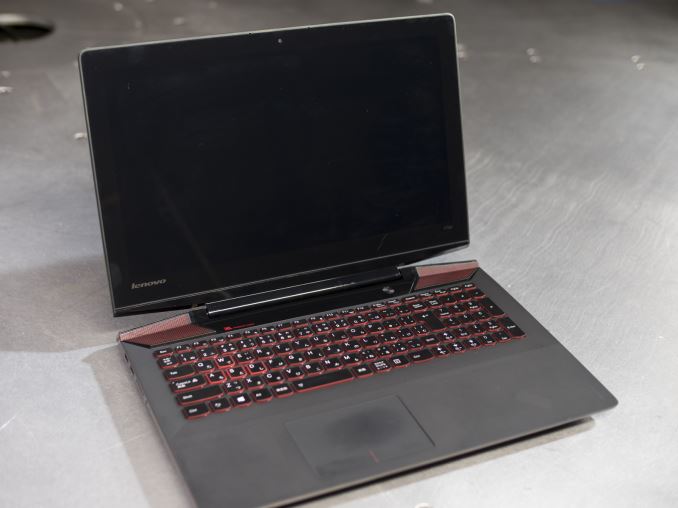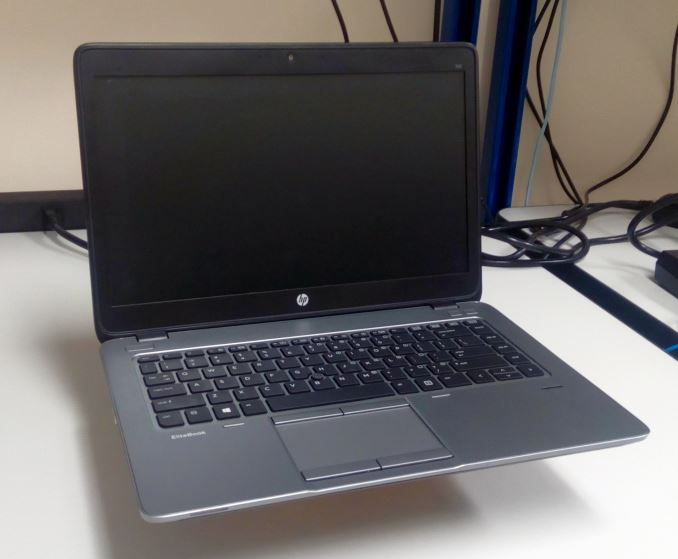Who Controls the User Experience? AMD’s Carrizo Thoroughly Tested
by Ian Cutress on February 4, 2016 8:00 AM EST
In Q2 of 2015, AMD officially launched Carrizo, their new APU aimed at mobile devices such as laptops and portable all-in-ones that normally accommodate 15W-35W processors. Quoted in the media as 'the biggest change to Bulldozer since Bulldozer itself', the marketing arm of AMD released information regarding the Excavator architecture of the new processor, and which contained a long list of fluid and dynamic implementations on improving the Bulldozer based architecture over the previous iteration of Steamroller (Kaveri). Despite this, AMDs target market for the Carrizo platform has not been receptive to AMDs product stack in recent generations due to issues surrounding performance, battery life and designs. AMD believes to have solved the first two of those matters with Carrizo, whereas the third is out of their hands and up to the OEMs to embrace AMDs platform. We wondered if the OEM’s concerns were well placed, and organized some special testing to confirm AMD’s claims about Carrizo.
Who Controls the User Experience: AMD’s Carrizo Tested
Back in early 2015, we performed a long analysis on Intel’s Core M platform, featuring 4.5W processors under the Broadwell microarchitecture. The purpose of that piece was to test several designs using that line of processors, and examining how the design of the chassis and features of the platform directly affected both performance and user experience. For Brett and I at the time, it was an eye opening endeavor, showing just how the slowest processor in a stack in the right notebook chassis can outperform the fastest, most expensive processor in a bad chassis that is wholly un-optimized.
This review is along similar lines, but instead we are testing AMD’s latest Carrizo platform, which is focused on 15W mobile parts in the $400 to $700 market. We approached AMD after the Carrizo Tech Day back in May with a proposal – to speak to engineers and to test the claims made about the platform. Typically sourcing AMD laptops, at least over the past few years, has been a veritable minefield as they are seemingly never promoted by OEM partners as review samples, or as one senior member put it, ‘Some sales people only seem to offer AMD devices if people specifically ask for them’. Our proposal involved sourcing a number of Carrizo laptops when they were launched and tackling them head on, to see how many of the claims made on the Tech Day were testable but also noticeable and true. The issue AMD and OEMs have is that everyone in the AMD-to-OEM-to-retailer chain is invested in selling the platform, so there needs to be a source of third-party testing for people who don’t trust that chain.
Over the course of a few months, our proposal changed and merged with ideas to speak with AMD’s VPs and engineers, with a number of meetings and discussions. It emerged the best way to do this was to fly to AMD’s HQ in Austin, Texas for a week and get hands on time in the labs. We agreed, as speaking to engineers and learning what is going on behind the scenes at AMD is always a good thing, but on the condition that we were free to setup, test and report without any predisposition to the results. There is an added benefit of having engineers only a floor or two away if a problem was to arise. There have been similar events in the past where media have been invited on-site for canned testing, but we made sure this wasn’t going to be the case before we arrived. For example, Qualcomm has invited select media to in-hand, temporary Snapdragon testing on a couple of occasions, with media free to test and report whatever results.
The Testing
We had four Carrizo devices on hand to test for a week, along with a single Kaveri system. These devices were sourced by AMD, and I put in requests for a variety of price points, hardware configurations and styles, along with some specific testing equipment to which we don’t have access. While it wasn’t possible to get everything on hand due to timing issues, the arrangement at least captured a number of areas we planned on testing.
The testing aimed to cover the devices as units, the underlying hardware, as well as the Tech Day claims. Some of this piece will read like a regular review, some of it similar to our Core M testing regarding performance, power and temperature, but a large part is reserved for discussing both the results and the market. When building a platform like Carrizo, a lot of binary decisions are made that can be good or bad for the processor manufacturer, the OEM or the user. We discuss these in detail as a result of our findings.












175 Comments
View All Comments
karakarga - Friday, February 5, 2016 - link
Including all, AMD and nVidia both at their funeral state! They can not possibly open 22, 14, 10 etc. micron fabric.Intel spended 5 billion dollars to open their new Arizona factory, they will pass lower processes there as well. AMD and nVidia can not get, even a billion dollar profit in these years. It is impossible for them to spend that much money to a new low process factory.
Those little tweaks can not help them to survive....
testbug00 - Friday, February 5, 2016 - link
They don't build factories. TSMC and Samsung (and GloFo to a lesser extent) build factories and do R&D for these processes. Nvidia, AMD. Samsung, Qualcomm, MediaTek and many other companies design chips to the standards of TSMC/Samsung/GloFo and pay money for wafers and running the wafers through the fab.The cost for this per wafer is meant to get all that money back in a few years. And than the process keeps on running for over 10 years sometimes.
It is getting more expensive to get to smaller nodes and the performance increase and power decrease is getting smaller. And costs more to design chips and run wafers. So it is getting harder to find the funds to shrink. Which is one of the reasons Intel has delayed their 10nm process.
yannigr2 - Friday, February 5, 2016 - link
Thanks for this review. Really needed for sometime. It was missing from the internet, not just Anandtech.As for the laptops, they say as much as there is to tell. Small Chinese makers, who no one knows they exist, would built better laptops than these. HP, Toshiba and Lenovo in this case, multibillion international giants that seems have all the technicians and the R&D funds necessary, end up producing Laptops with "strange" limitations, bad choices, low quality parts and in the end put prices that, even with all those bad choices and limitations, are NOT lower than those on Intel alternatives. It's almost as if Intel makes the choices for the parts in those laptops. Maybe their is a "trololol" sticker on them somewhere hidden addressed to AMD. I guess that way those big OEM don't make Intel too angry and at the same time, if there is another legal battle between AMD and Intel in the future, they will have enough excuses to show to the judge in their defense, if accused that they supported a monopoly.
ToTTenTranz - Friday, February 5, 2016 - link
This article is what makes Anandtech great. Just keep being like this guys, your work is awesome!I'm going to spend some time clicking your ads, you deserve it :)
As for the "poll" about who's to blame, IMHO it is:
1 - AMD for letting OEMs place Carrizo in designs with terrible panels and single-channel solutions. It's just not good for the brand. "You can't put a Carrizo with single-channel cheap RAM because that's not how it was designed. You want to build bottom-of-the-barrel laptop? We have Carrizo-L for you."
I'm pretty sure Intel has this conversation regarding Core M and Atom/Pentium/Celeron solutions. I know AMD is in a worse solution to negotiate, but downplaying Carrizo like this isn't good for anyone but Intel.
In the end, what AMD needs is a guy who can properly sell their product. Someone who convince the OEMs that good SoCs need to be paired with decent everything-else.
$500 is plenty for a 12/13" IPS/VA screen (even if it's 720/800p), 128GB SSD and 4+4GB DDR3L. Why not pull a Microsoft's Surface and build a decent SKU for that price range so that other OEMs can follow? Contract one OEM to make the device they envisioned, sell it and see all others following suit.
2 - OEMs for apparently not having this ONE guy who calls the shots and knows that selling a crappy system automatically means losing customers. And this ONE other guy (or the same) for not knowing that constantly favoring Intel with their solutions is bound to make the whole company's life miserable if Intel's only competitor kicks the bucket. The consumer isn't meant to know these things, but the OEMs certainly are.
It's 2016. We're way past the age of tricking the customer to buy a terrible user experience through big numbers (like "1TB drive woot"). He/She will feel like the money just wasn't and next time will buy a mac.
Want a $300-400 price point? Get a Carrizo-L with a 128GB SSD and a 720p IPS panel. Want $500-700 Price point? Get a Carrizo with dual-channel, 256GB SSD and 900p/1080p IPS screen.
joex4444 - Friday, February 5, 2016 - link
Anything under 1080p is simply not usable. All these 1366x768 panels are just awful. I have an old netbook with one (12.1") and I've put a small SSD in there and loaded it with Ubuntu. I cannot have a Google Hangouts window open and a web browser open wide enough to view most pages. Basic web browsing + IM - 1366x768 completely fails at the task.testbug00 - Friday, February 5, 2016 - link
768p panels are fine if they are good quality, in 11" laptops.900p good up to 13", and 1080p minimum for 14+.
Honestly I wish we stayed with 8:5 14x9, 16x10, 19x12z
jabber - Saturday, February 6, 2016 - link
Indeed, 768p is fine on my 11" Samsung Chromebook but I would not tolerate it on anything bigger. IMO 1600x900 should be the minimum screen res for budget machines. 1080p for midrange and whatever you like for higher end.jjpcat@hotmail.com - Monday, February 8, 2016 - link
Resolution is not as important as the quality of the panel. I used a Lenovo X1 Carbon. It has a 14" 1080p screen. But it's a TN panel and that just makes it a pain in the ass. I am amazed that Lenovo uses such a lousy panel in its $1k+ laptop while some 10" sub-$200 tablets use IPS.testbug00 - Friday, February 5, 2016 - link
Toshiba can make a $400 chromebook with a good 1080p display. Fully agreed.1080p panel, make it thicker so you can put a larger battery and so the laptop can handle up to 35W from the APU. Do dual channel.
When plugged change APU power mad to 35W, when in battery make it 15W. Probably can be done for $500 for a 15" laptop with an A8. $50/100 upgrade to 128/256GB SSD and $50/100 upgrade to A10/FX.
Dobson123 - Friday, February 5, 2016 - link
"The APU contains integrated ‘R6’ level graphics based on GCN 1.0, for 384 streaming processors at a frequency of 533 MHz."Isn't it GCN 1.1?